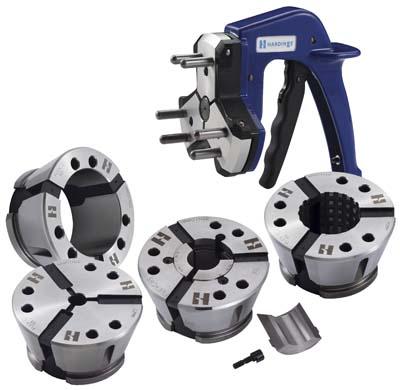
You've probably heard the term "vulcanized collet" and may have wondered what it means exactly. Vulcanization was named after the Roman God of Fire, Vulcan, and, yes, the injection molding process at Hardinge does involve heat. Vulcanization is a chemical process for converting rubber or related polymers into more durable materials, in this case, vulcanized rubber that permanently bonds hardened, chrome-nickel steel collet sections together. Why do we need vulcanized rubber in a collet head? Vulcanized rubber has superior elasticity for repeated opening and closing of the collet without deterioration.
Now that we have established an elastic design, a manual wrench can be used to compress the collet providing quick changeover in seconds instead of minutes! Add up all of the minutes saved and that equals reduced manufacturing cost. Quick changeover is not the only benefit you'll experience. The FlexC collet system proudly falls in the "special accuracy" collet classification having guaranteed accuracy within .0004" (.010mm) TIR for both collet system styles A (pull-back stationary stop) and D (pull-back thru-hole) and .0008" (.020mm) TIR for style DL (push-to-close dead-length).
These systems achieve the same gripping capability as conventional collets while using less draw bar force. Additionally, the all-too-frequent variation in bar stock will no longer be a hindrance. The collet head has a gripping range of +/-.020" (.5mm) of its nominal size to allow variation in bar stock without having to change the collet. Because there is no collet body, the collet segments will remain parallel to the stock even when there are variations in the bar stock. This parallel clamping minimizes stock "push back" that could create inconsistent part lengths.
Hardinge FlexC collet systems are compatible with many CNC lathes and are interchangeable with other brands on the market. Substitute a FlexC collet system for 16C, 20C and 25C collet applications to meet special accuracy requirements, or mount it on a chuck-style lathe or rotary indexer for increased versatility. The spindle mount will fit on A2-5, A2-6, A2-8 and some flat back spindles (main and sub). Once the FlexC spindle mount is attached, different collet head sizes can be interchanged from job to job. Hardinge stocks 42 and 65mm collet sizes in round smooth and serrated styles. Hex and square sizes are made to order. Some examples of custom-manufactured applications include stepped holes, special shapes and off-center work. An added bonus is the fact that FlexC collets can be shared with vertical machining centers using Hardinge FlexC Collet Blocks.
These modular collet blocks are compact with a low profile for increased axis travel and can be used on 5th-axis rotary trunnions as well. Whether it's a single part or a multiple-part setup, this system provides a solution for gripping parts in many shapes, sizes and materials. The Hardinge FlexC Collet Systems are ideal for the job shop environment where machines experience multiple changeovers daily, and stock variations occur. The quick collet changeover can increase output and lower manufacturing costs, while the special accuracy could qualify that machine to handle a wider variety of jobs. Test results from repeated collet actuation indicate a highly durable, fully sealed gripping solution.
Contact Details
Related Glossary Terms
- centers
centers
Cone-shaped pins that support a workpiece by one or two ends during machining. The centers fit into holes drilled in the workpiece ends. Centers that turn with the workpiece are called “live” centers; those that do not are called “dead” centers.
- collet
collet
Flexible-sided device that secures a tool or workpiece. Similar in function to a chuck, but can accommodate only a narrow size range. Typically provides greater gripping force and precision than a chuck. See chuck.
- computer numerical control ( CNC)
computer numerical control ( CNC)
Microprocessor-based controller dedicated to a machine tool that permits the creation or modification of parts. Programmed numerical control activates the machine’s servos and spindle drives and controls the various machining operations. See DNC, direct numerical control; NC, numerical control.
- flat ( screw flat)
flat ( screw flat)
Flat surface machined into the shank of a cutting tool for enhanced holding of the tool.
- lathe
lathe
Turning machine capable of sawing, milling, grinding, gear-cutting, drilling, reaming, boring, threading, facing, chamfering, grooving, knurling, spinning, parting, necking, taper-cutting, and cam- and eccentric-cutting, as well as step- and straight-turning. Comes in a variety of forms, ranging from manual to semiautomatic to fully automatic, with major types being engine lathes, turning and contouring lathes, turret lathes and numerical-control lathes. The engine lathe consists of a headstock and spindle, tailstock, bed, carriage (complete with apron) and cross slides. Features include gear- (speed) and feed-selector levers, toolpost, compound rest, lead screw and reversing lead screw, threading dial and rapid-traverse lever. Special lathe types include through-the-spindle, camshaft and crankshaft, brake drum and rotor, spinning and gun-barrel machines. Toolroom and bench lathes are used for precision work; the former for tool-and-die work and similar tasks, the latter for small workpieces (instruments, watches), normally without a power feed. Models are typically designated according to their “swing,” or the largest-diameter workpiece that can be rotated; bed length, or the distance between centers; and horsepower generated. See turning machine.
- parallel
parallel
Strip or block of precision-ground stock used to elevate a workpiece, while keeping it parallel to the worktable, to prevent cutter/table contact.
- total indicator runout ( TIR)
total indicator runout ( TIR)
Combined variations of all dimensions of a workpiece, measured with an indicator, determined by rotating the part 360°.
